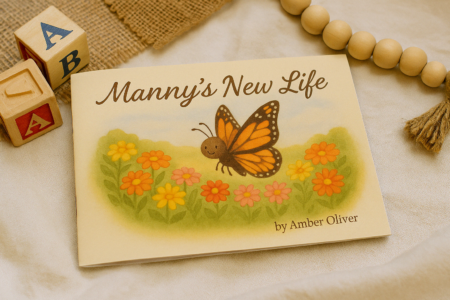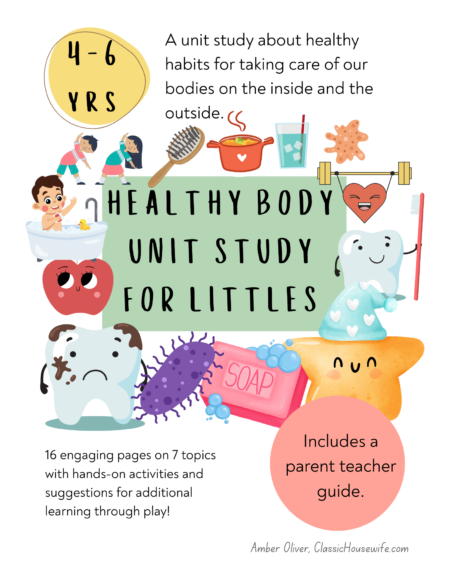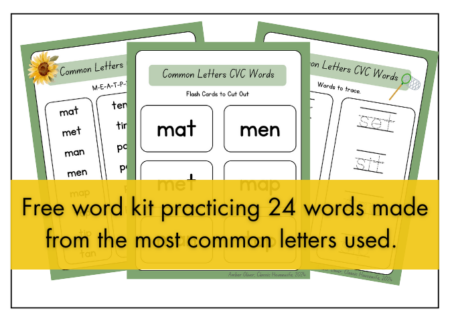A Gentle, Biblical Easter Lesson for Kids — That They’ll Actually Understand

There’s something so quietly magical about watching a butterfly take flight for the very first time. If you’ve ever had the joy of raising caterpillars with your kids, you know what I mean. The anticipation, the stillness of the chrysalis stage, and finally—the moment of transformation. That moment is exactly what inspired Manny’s New Life, a printable children’s Easter story I created to gently teach the gospel through the beauty of nature. If you’re looking for a Biblical Easter lesson for kids that feels thoughtful, age-appropriate, and simple to use, I think you’ll love what this little story has to offer. A Christian Easter Story Rooted in Wonder Manny the caterpillar starts out small—just like most big stories do. He eats, grows, wonders, and eventually finds himself wrapped in something mysterious and still. What happens next isn’t just a change. It’s a complete transformation. And that’s the heartbeat of the gospel, isn’t it? In Manny’s New Life, kids discover that just like Manny, when we trust Jesus, He doesn’t just make us better. He makes us new. This Christian Easter story for kids weaves together Scripture, science, and a relatable character journey to help children understand what salvation really means: not just trying harder, but becoming a new creation. What’s Included in the Printable Whether you’re planning a last-minute Easter unit in your homeschool, prepping a Sunday school lesson, or looking for a meaningful gospel-centered resource to tuck into an Easter basket, Manny’s New Life is ready to go. Here’s what you’ll get in the download: All of it fits onto standard printer paper and assembles into a sweet, compact booklet you can use again and again. Solving Real Problems for Real Families Let’s be honest: finding biblically sound Easter materials for kids that are theologically accurate and age-appropriate can feel like a treasure hunt. Some resources are too fluffy—just bunnies and eggs with a Bible verse slapped on top. Others go so deep, they miss the heart of the child entirely. Manny’s New Life meets kids right where they are, using something they already love (butterflies!) to gently introduce spiritual truth. It’s simple enough for preschoolers to follow, but meaningful enough to spark real questions in older kids too. No prep. No fuss. Just print, cut, staple, and read. Why Kids Will Love It Kids love stories that speak their language—and Manny does just that. He’s curious. He’s unsure. He changes in ways he doesn’t understand. And in the end, he soars. The illustrations are soft and cheerful, with flowers, gardens, and fluttering wings that invite little hearts to linger. The pacing is gentle, the language clear, and the message unmistakable: God changes us from the inside out. For visual learners, the butterfly imagery makes the gospel feel real and tangible. For sensitive hearts, it’s comforting and kind. And for little thinkers? It’s a springboard into deeper conversation. A Biblical Easter Lesson for Kids That Feels Doable Whether you’re a tired homeschool mama (hi, same), a Sunday school teacher juggling multiple age groups, or a parent looking to bring Christ back to the center of Easter morning, this printable is here to make it easy. There’s no long script to memorize. No supplies to gather. Just a meaningful Bible-based Easter lesson tucked into a storybook format that kids can engage with on their own level. Use it as a read-aloud during circle time. Pop it into a morning basket. Print a copy for your Sunday school class. Or curl up on the couch and read it together before bed. However you use it, Manny’s New Life helps you plant seeds of truth—and water them with wonder. Ready to Share the Joy of New Life? Jesus didn’t just die for us—He rose again to give us new life. And that truth is too good not to share with our children in a way they can really see and understand. If you’ve been looking for a Biblical Easter lesson for kids that feels gentle, meaningful, and ready-to-use, I’d love for you to check out Manny’s New Life. It’s available now in the Wrinkles & Rainbows shop, just in time for Easter. Let’s tell the next generation what God can do—with butterflies, with broken hearts, and with every little life He calls His own. Find Manny’s New Life Here Below:
Healthy Body Homeschool Unit Study: Helping My Strong-Willed 4-Year-Old Build Healthy Habits

Healthy Habits, Healthy Body If you’ve ever tried to convince a very opinionated 4-year-old to brush their teeth, wash their hands, or eat a vegetable — you already know the struggle. I know it well, too. (And this is why we now have the Healthy Body Homeschool Unit Study.) Lil Miss Mouse (our sweet and spunky 4-year-old) is full of life, imagination, and a strong will. And while I absolutely love her firecracker spirit, I’ll be honest — it has made some things really challenging. Like… convincing her to brush her teeth without a fight. Or getting her to wash her hands after using the bathroom without a dramatic sigh. Or asking her to eat something green without the dreaded, “I don’t like that.” I get it. To her, brushing her teeth just feels like an annoying task I was forcing on her. Washing her hands is boring. Eating healthy isn’t as fun as eating dessert. But I worry about her health when all she wants is junk and she resists brushing her teeth, ya know? And honestly? I don’t want healthy habits to feel like a power struggle — I want them to feel natural for her. Something she actually wants to do. So… I got an idea. What If I Made Learning About Good Habits for a Healthy Body FUN? One night I had a thought: What if I approached this differently? What if I turned healthy habits into something she could explore, play with, and learn about in a hands-on way — instead of something I just nagged her about every day? I know that kids learn better and remember more when they learn through playing. I decided to create a few little activities to help her understand why we brush our teeth, wash our hands, eat healthy, and stay active. But then… I did the ADHD thing and I researched and hyperfocused and next thing I knew, I was elbows deep in a unit study. The more I brainstormed, the more I realized there was SO much I wanted to teach her about taking care of her body — not just hygiene, but also nutrition, exercise, and rest. And the more excited I got, the more I kept adding to it. And then, BOOM!, I had a fun, full, (and fabulous) Healthy Body Homeschool Unit Study. And honestly? It turned out way better than I expected. The Best Part About the Healthy Body Unit Study – She Likes It When we sat down at the table for the first lesson of the healthy body unit study, Lil Miss Mouse was immediately drawn to the pages on brushing teeth. We talked about germs (bacteria,) cavities, and brushing teeth before diving into the activities. And you know what? She had fun! She drew and erased and cleaned food bits off the teeth at least a dozen times. She did the same with the flossing activity. For each, I demonstrated the correct technique and had her practice. The next day we did a lesson about healthy foods. We sorted foods into “more healthy” and “less healthy” categories. For many reasons, we are just sorting foods into things we should eat more often and foods we should eat less often. (We do have things we avoid altogether, like artificial food dyes, but that’s a whole different lesson.) After that, she started pointing out healthy choices during meals or asking “mom, is this more healthy or less healthy?” Making wise food choices became just a little bit easier. Funny: when I asked her to circle all the ways she likes to play and move on the exercise page, she circled all of them. Every single one. (She hasn’t even ever played tennis!) But I’m not surprised because this girl loves to move. Inspired by that activity, I decided to get a kite from Dollar Tree and teach her how to fly a kite. We have had great weather for it, she loves it, and now we have one more way to get fresh air and exercise together. =) We’ve Still Got a Ways to Go, But We’ve Made a Good Start Now don’t get me wrong — we didn’t magically solve everything overnight. There are still moments when she sighs dramatically about stopping to wash her hands. But good habits take TIME. She understands why we do these things. She knows that brushing keeps her teeth healthy, eating fruits and veggies makes her body strong, and washing her hands keeps her from getting sick. And while we’re still working toward consistency, I can tell you this: And honestly? That’s more than I hoped for when we started. And Now It’s a FULL Healthy Body Homeschool Unit Study (and It’s in the Shop!) I ended up turning everything we did — all the lessons, hands-on activities, and printable worksheets — into a Healthy Body Homeschool Unit Study for kids ages 4-6 complete with a parent/teacher guide. SIXTEEN pages of unit study, SIX pages of parent guide, and about two weeks’ worth of lessons (should you choose to space it out that much.) It covers things like: And also? It’s just… fun. Short lessons. No lengthey lectures. Just play-based learning that helps kids understand why their health matters. It’s On Sale Through the End of March Since I know so many other homeschool moms face the exact same struggles I did, I put the Healthy Body Unit Study up in my shop — and it’s on sale through the end of March. If you want to check it out, you can grab it here: Healthy Body Unit Study And if you do end up using it with your kids, please tag me on Instagram or Facebook [@ClassicHousewife] — I’d love to see it in action in your home. It’s nice how something that started out as me trying to solve a problem turned into some way that I can help other families do the same. Isn’t that one of the good things
A free word kit for the most frequently used letters.

In my last post about teaching phonics to preschoolers, I mentioned that one approach is starting with most commonly used letters in the alphabet. Which letters are the most frequently used you might ask? I came up with the mnemonic MEATPINS to help you remember. The most frequent letters are a, e, i, m, n, p, s, and t — and the only word I could come up with is the nonsense word “meatpins.” (I welcome other suggestions.) ;p Anywho,… back to the matter at hand: phonics. I naturally started teaching Lil Miss Mouse the letters m and d first because of “mom” and “dad” and also because her name begins with an M. After I started teaching her some letters I found this “common letters” approach and it just made sense. I recently realized just last week that she’s been exposed to the words “mom” and “dad” so much, along with hers and her siblings’ names, that she can now recognize each of them consistently. She surprised me though when she also recognized the words “dog” and “cat!” It’s time to start working on phonics more. Now that she’s learning to recognize words, pretending to read, asking how to spell words so she can write them, and pointing out letters on signs and billboards, it’s time to give her more opportunities to expand her skills. Remember: without pressure to perform though — she just turned four and there’s no rush. She gets to learn at her pace. To this end, I’ve made a little CVC word kit using these most frequently used letters… and what’s more, I’m putting it in the store for free so you can you use it, too. In this kit is a word list in two options (one with an ant and one with a butterfly depending on what your child likes,) some flash cards to cut out, and some tracing words to trace. You can laminate the flash cards and reuse them again and again. You could even laminate the tracing sheets and use dry erase markers with them. As I suggested in my previous post, combine these with physical ABC letter manipulatives (wooden letters, magnetic letters, scrabble tiles) for a more hands on approach and let your kids build the words they’re learning before trying to write them. Writing can sometimes be frustrating for young children because their hands really haven’t developed enough to do it as well as they would like. The free kit is in the shop. You’ll find the free kit in my shop, here. Just add to cart, checkout (for free) and download. Let me know if you have issues. Enjoy your word kit and leave some feedback on it, if you will. Tell me what else you would like to see in the shop, too. I have a running list of about a dozen projects I want to make in Canva, more ideas are welcome. It’s just a matter of choosing which one to work on next. 😉 Happy teaching!
